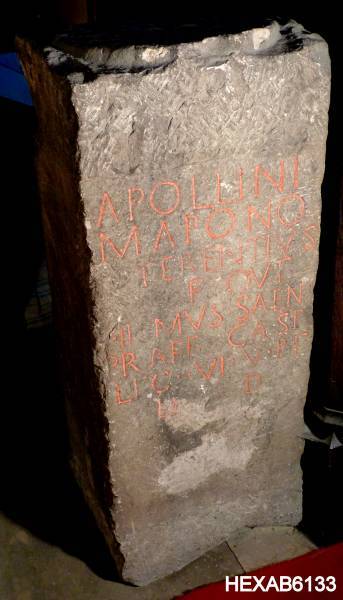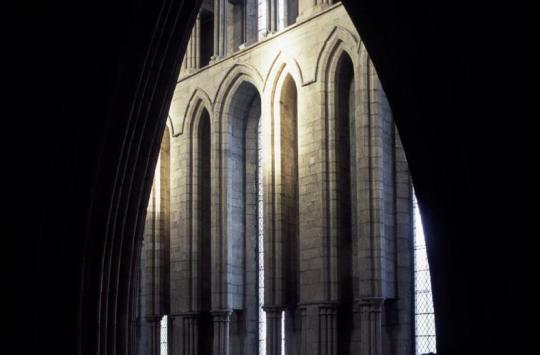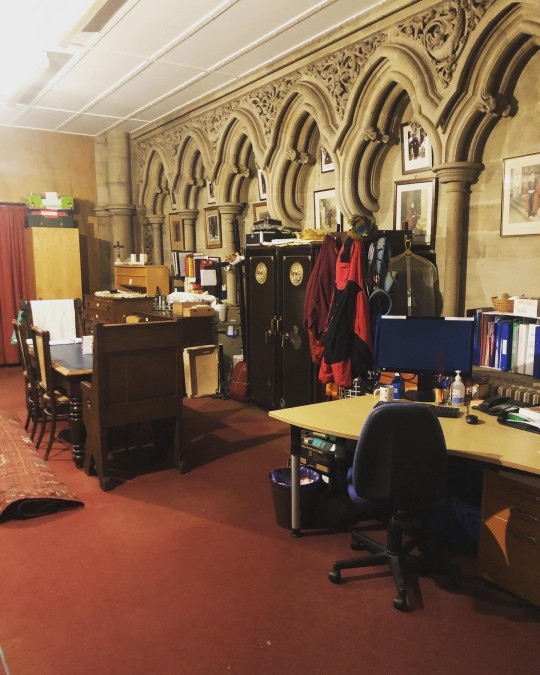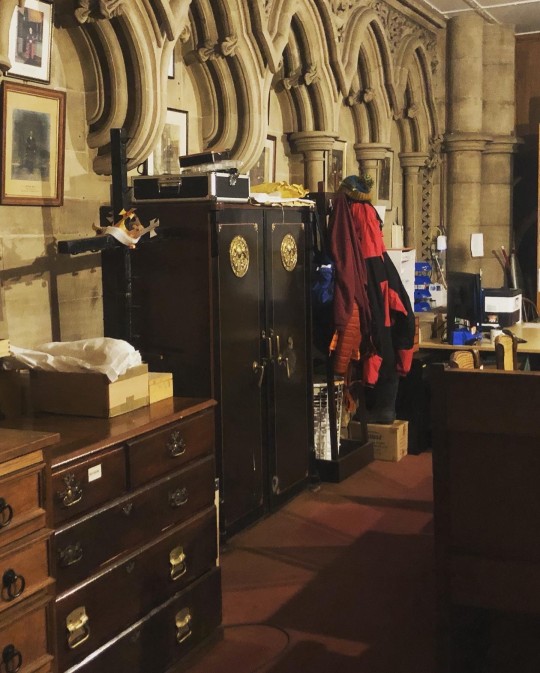Photo

Whilst looking through copies of the Abbey Chronicle from the early 1960’s, I came across an intriguing photo and caption:
THE ABBEY SHOP £10,000 SALES
‘The Abbey Shop – with Dorothy and Stella – now a well-known Hexham landmark, where we
have found you can leave parcels, shopping, and babies! – temporarily; scrounge a cup of
coffee, collect articles and tickets for Abbey social functions, find the Gang, get to know where the Rector is – and buy anything from a Christmas Card to an egg-cup.
(By courtesy of J. E. Hedley, Esq.)’
I had to put aside what I was looking for to read the article, as the photo of the Abbey Shop looked completely different from the shop we know and still love today. It soon was apparent from the article that there had been such tremendous help and support from the Abbey family and local community to make the Shop a reality.
In September 1957, the first Shop was opened in premises on Fore Street, kindly lent to the Abbey by the Directors of the Scottish Wool Co. Indeed, the Chairman of the company made table and shop fittings from old wood, and there was such a buzz of activity as the Shop was set up and opened. The volunteers had to put up with freezing weather in the winter but were heartily cheered by masses and masses of mail received with donations to “The Appeal”.
The first items that were sold were Guides of the Abbey and Town, a selection of Christmas Cards, and also Calendars. Despite this limited range, the volunteers made £814 from September 1957 to March 1958. These were happy days and they still are in the Shop we have today.
Then the Shop had to move, as the premises in Fore Street were needed by the owners. Again the Abbey was grateful for the loan of a caravan from a friend, which was situated near where the Shop is today. Although space was tight the shop volunteers managed to extend their lines by introducing Hexham Abbey Tea Towels and Staffordshire Black and White Pottery, which proved extremely popular with the visitors.
But by early spring of 1959 the Shop was bursting at the seams, and Messrs Lowerys (our Restoration Contractors) purchased and most graciously lent to us the shop you see today. Also in 1959, Miss Dorothy Reid, who was one of the original helpers and was managing the shop, introduced the sales of Coffees and Cold Drinks, which created quite a stir. How she and her helpers managed with the restricted space and water heating difficulties, is hard to say, but the venture greatly increased the money raised for the Appeal. New Abbey souvenir lines were also introduced, and the Committee were careful not to chose items that other Hexham traders carried, so avoiding competition.
Over the six-and-a-half years since the Abbey Shop opened, the volunteers sold merchandise and drinks totalling over £10,000, which contributed in excess of £3,000 to the Appeal Fund. After the many, many hours of service given to the Abbey Shop, the Restoration Committee and all who were interested in the Abbey gave heartfelt thanks to Miss Reid, her band of helpers, and ‘The Gang’, who had always been ready to help.
After reading the article and studying the picture it would be good to know if anyone can remember those early years of the Abbey Shop.
I would dearly love to hear from anyone who can remember the Abbey Shop back in the late 1950s and early 1960s:
Were you one of Miss Reid’s helpers?
Can you remember the caravan, or maybe have a photo?
Did you know Dorothy or Stella?
Were you one of the babies left ‘temporarily’?
Who was ‘The Gang’?
Do you have any China or Tea Towels purchased from the Shop?
And, most importantly, did you really know where to find the Rector!!!
It would be great to hear from you.
Frances Stride
Reference: The Abbey Chronicle, Edition dated April 1962, Page 3
0 notes
Text
An Altar to Apollo
At the beginning of our exhibiton, the first thing you will see if a great big hunk of stone with some red lettering on, which at frist glance doesn’t make much sense at all. But with further inspection, you will learn that it’s a rather interesting stone after all!
This is a Roman Altar, used to worship a local Roman god called Maponos, a Celtic god of youth and love who was often linked with Apollo, the Roman god of the sun, light and music. Maponos was worshipped in North Britain and Gaul, and was famed for skills in poetry, music and hunting. The centre of his cult may have been at Lochmaben, Dumfries.
The red lettering translates is Latin, which translates into English as:
‘To Apollo Maponus … Terentius Firmus Senianus the son of … of the Oufentine tribe, prefect of the camp of the sixth legion, styled the victorious, pious and faithful, dedicates this altar’
This stone altar was found at the site of the old church in 1864 when the grounds were being dug up and levelled out for the creation of Beaumont Street.


6 notes
·
View notes
Video
youtube
Set in Stone is a short film that introduces you to the wonders of Hexham Abbey, using drama, animation and lots of humour. The film has been created, written, acted and produced by crew members of FilmAble, a production company for adults with learning difficulties run by the Haltwhistle Film Project. Time-travel to different eras from the Abbey's past to discover the key people and events that have shaped the Abbey's story, and find out what the building means to people today.
0 notes
Text
£24,500 Grant Awarded for Essential Crypt Repairs

e are delighted to announce that Hexham Abbey has received a financial boost from the government’s £1.57 billion Culture Recovery Fund to help fund repairs during the coronavirus pandemic.
A grant of £24,500 has been awarded to allow environmental investigation work and masonry repairs to the Abbey’s Anglo Saxon Crypt. Preserved and largely unchanged in 1,300 years, the Crypt is the only part of a church built on the site by Bishop Wilfrid in 674AD that survives intact.
This funding comes from a part of the Culture Recovery Fund called the Heritage Stimulus Fund and is administered on behalf of the government by Historic England. The grants of up to £25,000 are being allocated to cherished heritage sites across the country to cover urgently needed manintenance and repairs.
As well as rescuing precious heritage buildings in need, the injection of cash will protect livelihoods for some of the most vulnerable heritage specialists and contractors working in the sector.
The Revd David Glover, Rector of Hexham said:
“Our Anglo Saxon crypt would normally be attracting tens of thousands of visitors a year and it is vital that we do all that we can to preserve it. It is the last intact part of the original church built here by Bishop Wilfrid 1,300 years ago, so it’s of immense historical and religious significance.
“Hexham Abbey is of international heritage standing and we are absolutely delighted to receive this grant from Historic England at a time when additional grant funding is also allowing us to proceed with our important Abbey Roof refurbishment. The work here, using the very best in skilled workmanship and the very highest conservation techniques, will help preserve this incredible building for our future generations.”
Culture Secretary, Oliver Dowden, said: “These grants will help the places that have shaped our skylines for hundreds of years and that continue to define culture in our towns and cities. We’re protecting heritage and culture in every corner of the country to save jobs and ensure it's there for future generations to enjoy.”
Duncan Wilson, Historic England Chief Executive said: “Historic places across the country are being supported by the Government’s grants awarded under the Culture Recovery Fund. This funding is a lifeline which is kick-starting essential repairs and maintenance at many of our most precious historic sites, so they can begin to recover from the damaging effects of COVID-19.
“It is also providing employment for skilled craft workers who help keep historic places alive and the wheels of the heritage sector turning. Our shared heritage is an anchor for us all in these challenging times and this funding will help to ensure it remains part of our collective future.”
#hexhamabbey#visithexham#visitnorthumberland#heritagesite#culturalrecoveryfund cryptrepairs saxon roman hereforculture
0 notes
Text
Our Roadmap out of Lockdown

Plans are now emerging for the re-opening of the Abbey for services, prayer and reflection, hospitality, general visiting, and events. In our planning we are being careful to adhere to national legislation and to the importance of maintaining everyone’s safety. We also need to contend with the ongoing roof works which will continue to affect the inside of the Abbey until Good Friday. However, we also recognize the huge spiritual and social importance of in-person worship and so the following sets out the Abbey’s roadmap for re-opening.
Palm Sunday 28th March
The first in-person service in the Abbey will take place at 6.30pm on Palm Sunday and will be a service of reflections, music, and prayers for Holy Week.
Monday 29th – Thursday 1st April
On each of these evenings there will be a Eucharist in the Abbey at 7pm. The Abbey will be open for private prayer from 6pm.
Good Friday 2nd April
The Abbey will be open for private prayer from 12 noon and there will be a service of “Gathering around the Cross” at 2pm.
Easter Sunday 4th April
There will be an Easter Day Parish Eucharist at 10am. The Abbey will remain open for private prayer and reflection until 3pm. There will be an Easter Refresh at 6.30pm
Easter Monday 5th April and every day until 17th May
The Abbey will be open for private prayer and reflection from 11am – 3pm (subject to the removal of scaffolding which may affect opening on some days).
Tuesday 6th April and then each Tuesday
There will be a Eucharist at 12 noon
Sunday 11th April and then each Sunday
Parish Eucharist will be at 10am and Evening service (Evensong. Refresh or Revive) will be at 6.30pm.
Monday 12th April
Morning Prayer will resume in the Abbey at 9am. Evening Prayer will resume in the Abbey at 5pm. The Refectory Café will open with outside seating only and the Abbey Shop will re-open.
Wednesday 14th April
Tots’ Praise resumes at 9.30am
Monday 17th May
The Abbey will open for general visiting from 1oam to 5pm each day. The Refectory Café will be fully open.
Monday June 21st
By this date the government’s current roadmap envisages that most, if not all, Covid related restrictions will be lifted. Well in advance of this date we will communicate about all Abbey services, activities and events.
Covid protocols, social distancing, Choirs and Children’s worship
When we return to the Abbey we will be re-instating all our Covid secure measures which will include: the requirement to wear a mask, social distancing, track and trace, extra hygiene measures, no congregational singing etc.
At present it is not known when Choirs will again be allowed to sing in Church. Because of this the above roadmap does not mention the resumption of Wednesday and Thursday Evensong. However, as soon as choirs are permitted, we will look to resume these services. Likewise, choirs will return to Sunday services as soon as legislation permits.
We hope to resume Messy Church as soon as possible and more information about this will follow soon.
In addition to the re-opening of the Abbey, worship via Zoom will continue, albeit at different times from the current pattern.
The above roadmap is not exhaustive and does not cover every aspect of Abbey life but we hope it gives a clear direction of travel. As the ending of Covid measures emerge, we will review the ongoing pattern of services and events and keep everyone informed.
Rector and Churchwardens
10th March 2021
0 notes
Link
The 2,000-year-old remains of a dog with its fur still intact have been found at a Roman fort.
The rare find was made at Vindolanda, Hexham, near Hadrian’s Wall in Northumberland, and has been sent for analysis to determine the dog’s breed.
It was part of a haul made by a team of 400 volunteers who pay for a place to excavate at the site each year.
Continue reading
84 notes
·
View notes
Photo

The transepts at Hexham Abbey dappled by the evening light #architecture #photography #medieval #Gothic #heritage #heritagetreasures — view on Instagram http://ift.tt/2GtMMpO
67 notes
·
View notes
Photo

Suffragettes writing ‘Votes For Women’ on the pavement during the Hexham by-election, 1907.
30 notes
·
View notes
Text
January 2021
In a turbulent start to 2021, we found ourselves entering into January under a thick cloud of uncertainty and a unmistakable feeling of hopelessness. However, my despair at closing the Abbey’s doors to visitors again was lessened - as this time, we were not only closing the doors to combat COVID-19, but to race on at full steam with the repair works on the Abbey’s roof. Once the Abbey’s doors closed on the 4th of January, a team of hi-vis clad merry men descended upon the Abbey through the great west door, scaffolding poles under arms and bright white hard hats atop their heads. Light hearted banter and catchy whistling tunes filled the great Norman arches of the church, and for the first time in a long time, I found myself forgetting about COVID-19. Much like the sigh of relief I felt the Abbey take back in July 2020, when we held our first in-person service since March, the church sighed in relief again, relived in being able to concentrate on the future of the Abbey’s presence through the essential repairs to its roof. The week I spent wrapping, covering and protecting the inside of the Abbey in preparation for the outside works to begin reminded me of why it is that I have the best job in the world. I am blessed to be able to answer questions from visitors all day. I am blessed to have to re-stock visitor guides twice a day. I am blessed to run back and forth from the crypt to allow pilgrims and tourists down. I am blessed to spend a day each week moving furniture, because it means that there is a need for the Church. And there will always be a need for the Church, whether the person is pursuing knowledge of the past, reassurance for the future, or simply a safe place to seek sanctuary in the present. So, when the roof is repaired and the vaccine’s have truly begun their work, I will be blessed to re-open the wooden doors of this historic, everlasting Church once again to the people it serves.
Louise Weaver
Head Verger, Jan 2021
0 notes
Video
youtube
At the bottom of the Night Stair, stands a sandstone memorial to a Roman standard bearer. Dating from the 1st century, this stone may seem unsuited to the Abbey, but it is a reminder of the Roman domination of this part of England, centuries before Wilfrid arrived.
0 notes
Photo

35 stone steps rise from the south transept of Hexham Abbey, worn by constant use since the 13th century.
The Night Stair is a vivid reminder of the time when the canons lived, worked and worshipped in the Priory. Before dawn each day, the Priory bell would summon them to Matins, their first service of the day. They would descend from their dormitory, which no longer survives, down the Night Stair, on their way to the service in the Choir.
When the Priory was dissolved in 1537, the canons were pensioned off and the dormitory fell into decay. It was eventually demolished, and the Song School now inhabits the site where it once stood. But the Night Stair at Hexham survived, unlike those at other abbeys such as Fountains, Rievaulx and Finchale.
The Night Stair is still in frequent use today. The choir uses it regularly, and it is adorned with candles or flowers on festive occasions. The gallery at the top of the Night Stair is the perfect place for a fine view of the transepts, the organ and the screen, and the jewel-like Victorian stained glass that fills the 13th century lancet windows.Thirty-five stone steps rise from the south transept of Hexham Abbey, worn by constant use since the 13th century. A rare surviving example of its type, the Night Stair is an atmospheric reminder of the Abbey’s history as a monastic church.
0 notes
Photo

It is possible that Wilfrid had this stone seat made when he first founded the monastery here in 674. He had travelled through France on his way to Rome, and it is possible that he took his inspiration for the Frith Stool from examples on the continent, where they were used by bishops presiding over their teams of clergy.
Hexham was a cathedral, at the centre of a diocese, from about 678 to about 821, and this seat may have been the bishop’s 'cathedra', or official seat.
The word 'frith' is of Anglo-Saxon origin, and means 'peace, security and freedom from molestation'. In medieval England, it was possible for those fleeing conflict and persecution, and even justice, to claim sanctuary in a church. The frith stool, traditionally located near the high altar, was considered to be the safest and most protected place in the church for such refugees.
1 note
·
View note
Photo



A sneak peak into the verger’s lair...also known as the vestry. Since it’s relocation from the west side of the Abbey in the 19th century, the current vestry has housed many members of clergy and vergers. It is in here that the clergy, readers, lay people and vergers don their vestments before services. Along the stone wall are famed images of some of the vergers who have served at Hexham Abbey, with today’s spotlight on a Mr Downey, who served as a verger from 1858 to 1907!
1 note
·
View note
Photo


‘A church of deep prayer, a church that is bright, lively, colourful. A church that provided food, medical care, places for young people to meet safely, a church that could help the poorest and most vulnerable to know, deep within, that Jesus loves us’ - Rev. Canon Philip Cunningham
0 notes
Text
CULTURE RECOVERY FUND GRANTS HEXHAM ABBEY FUNDS FOR ESSENTIAL ROOF REPAIRS
We are delighted to announce we have been successful in a bid to help fund essential roof repairs to the Abbey. The worst affected areas of the roof; the Chancel East End, North Transept and Nave North Aisle will all have major repairs works undertaken, securing the building for future generations. The current slate roof coverings are in poor, deteriorating condition and over the past decade have required continual repairs to ensure the building remains wind and water tight.
Just under £357,000 has been awarded for the roof project, meaning works undertaken will include:
- The Westmorland slate and Welsh slate coverings will be carefully removed
- Removal of failed fixings and battens
- Repair and treatment of any decayed and infested exposed timber work
- Formation of new treated counter and tiling batten structure with breather membranes
- Re-laying of the salvaged existing slates
- Renewal and repair of the failed lead items.
The risk of not carrying out the work is that timbers will likely decay and rot, causing irrevocable damage to the medieval roof.
The Rev'd David Glover has said:
"We are delighted to have been awarded a grant from Historic England for just under £357,000 to enable repairs to the roof. The grant from Historic England will meet just under 80% of the cost of the works and the PCC is hugely grateful to the Hexham Abbey Restoration Trust for meeting the remaining amount.
This is great news for us because raising money to repair a roof would normally be very challenging and it has been a superb effort, led by Richard Thornton, Cath Newson and Kirsty Wills, that has enabled us to win this grant. Well done to them – and thank you!
This does, however, mean that the Abbey will need to be closed to all activities from 4th January – 31st March 2021. This is because the Abbey will need to be protected from the dust that will be created by disturbing the roof and, therefore, pretty much wrapped in plastic sheeting. During this time, we will make extensive use of the Priory Building, and especially the Great Hall, for our services and activities and the café and shop will remain open. The terms of the grant mean that the roof work should be completed by the end of March and we can look forward to being back in the Abbey for Easter. I do appreciate that we will, again, miss being in the Abbey Church but this is a fantastic opportunity to complete the first stage of our roof refurbishment, which is vital if we are to ensure the long term viability of the Abbey.
If you have any questions about this, please do not hesitate to speak to me or to a Churchwarden."
For full details please click the following link:
https://bit.ly/2IkLHG7
1 note
·
View note

